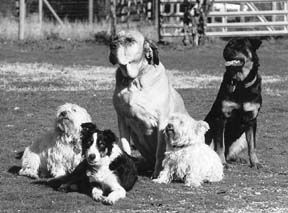Are you thinking about adding a second (or third, or fourth) dog to your household? Will your current dog be thrilled with a new friend? Will the dogs play with each other, romp together, and keep each other company in your absence? Or will adding another dog to your home create disharmony, chaos, or worse?
Living in a multi-dog home can be very rewarding. I have to admit that nothing warms my heart more than seeing our two girls playing or sleeping together; their affection for each other is truly a joy to behold. And there are other great reasons for adding another dog to your household:
• You have room in your heart for a new family member.
• You want to provide a good home for a dog in need.
• You have the time, money, and space.
• You think your dog would enjoy the companionship of another dog.
But living with multiple dogs brings a whole new set of challenges. Adding a second (or third, or fourth) dog means more fun, more love, more joy and more wonderful doggy companionship. But it also means much more from you: more time, more money, more energy, and more working through problems.
For example, many people consider adding a second dog to their households because their first dog seems lonely, and this is understandable. However, it may be a mistake if it’s your primary or only reason. Bringing a new dog home doesn’t mean the two dogs will immediately become friends. Nor does it mean your dog will be less lonely, play more, or have a better life. In fact, it could mean more stress, especially during the adjustment period, and less attention from you.
Another reason people adopt a second dog: “I saw him at the pet fair and fell in love.” While having an emotional affinity with a dog is a part of what makes our human/dog relationships work (and adoring the new addition can really help when he pees on your favorite rug), sometimes, falling in love with a particular animal can cloud common sense. In the case of a multi-dog household, our emotions need to be dramatically tempered with common sense.
Remember, having a second dog always requires an output of more time and energy. You will also need to be sure that you really do have enough money, space, and affection for two or more dogs. In addition, you’ll need to make sure that your current dog is suited for living with another dog.
Is your dog a good candidate?
There is no single way to determine if a dog will do well with another dog in the home. In general, dogs that are confident, calm, and friendly toward other dogs may be good candidates for the multi-dog household. Finding a suitable companion for a dog who is nervous, shy, or fearful around other dogs may be much more difficult.
If your dog has never lived with another dog, take some time to evaluate your dog’s personality and his or her affinity with other dogs. Does your dog, in general, get along well with other dogs? Does she play with other dogs? Does she have dog friends? Does she only like certain dogs? How is her confidence level around other dogs? How does your dog behave if another dog visits your home?
If you are not sure of the answers to these questions, you might want to do a bit more research before you make a decision about whether or not to add a second dog. Consider taking your dog to a play group, doggy day care, or another place where he or she can engage with well-socialized dogs. Consider having a “trial run” by fostering a dog or having a suitable dog friend come and visit for a weekend. Talk to your trainer or other animal care providers and ask their opinion on whether your dog would be a good candidate multi-dog household.
Use special caution if your dog displays aggression toward other dogs. A dog who is aggressive with other dogs outside the home may or may not be able to learn to live with another dog. In some cases, aggressive dogs do very well with dogs that are part of their pack. In general, however, finding a suitable companion for a dog with aggression issues will be much more difficult (remember that any new dog you bring into the home will, at least initially, be outside the pack) and safety will need to be a primary consideration. If your dog has any type of aggression issues and you would like to consider adding another dog, consult with a good behavior counselor to help you make the decision.
Even if a dog is generally friendly toward other dogs, he or she may not be a suitable candidate for a two-dog home. Older dogs who have always been the “only dog” may find a new dog in the home upsetting. If you and your dog are extremely close, he may have trouble “sharing” you. Dogs who are shy around other dogs (even if they are not aggressive) may find the addition of another dog simply too stressful.
When NOT to get another dog
There are some very good reasons to keep your house as a home to only a single dog. You may want to think twice about adding another dog if:
• You don’t really have enough time for your current dog. Getting a second dog won’t fill a void left by your lack of time. You’ll simply have two dogs that aren’t getting enough attention. A handout from the Humane Society of Silicon Valley (Santa Clara, California) suggests that a second dog will take about five extra hours a week of your time (I’d double that estimate for a young, energetic dog).
• You can’t afford a second dog. Consider not only the basic costs of food, grooming, toys, and regular veterinary care, but also the big costs, like a serious illness.
• Your dog has behavior problems or is not yet trained. Adding a second dog is likely to compound behavior problems, not solve them. For example, instead of having one dog who barks while you are at work, you are more likely to end up with two barking dogs. In addition, it is much easier to train your first dog before you bring a new dog into the home. (I know from personal experience that two unruly dogs are exponentially more exasperating than one!)
• You’re going through other life changes, like a new home, new baby, or loss of an older family dog. Wait until high stress times have settled and your home is stable before adding the additional stress of a new dog.
• You like your dog and your life exactly as it is now. Sometimes, we want to add a second dog because we anticipate the future – such as our dog growing older or even dying – and want to get a second dog to help ease the transition. While this is a valid sentiment, adding a new dog now will change the dynamics of your family. Your new dog may demand more of your attention, making it difficult to maintain the same level of relationship you’ve enjoyed with your first dog.
• You’re walking past an adoption center, you see a cute puppy in a window . . . Stop. Think twice. Go home and talk it over with your dog.
Finding a second dog
Bringing a new dog home is adding a new family member. Each of the family members will need to “get along” with the new addition – people and animals alike. Think long and hard about what you want in a new dog. Are you looking for a couch potato dog to hang out with after a long day at work? Do you want a running companion or a playmate for your younger dog? Do you want a dog to travel with? Do you enjoy dog sports like agility or obedience? Do you have cats or other animals to consider? For the sake of harmony in the home, also think about the type of dog that will be the most suitable match for your current dog.
Some of the things to consider are gender, size, and age. Most experts agree that, as a rule, male and female dogs get along better than two females or two males. However, that being said, I’ve known many households (including my own) that successfully have two of the same gender dogs without any problems at all.
It is also generally safer to have dogs nearer in size; they can be better matched as playmates and there is less risk of accidental injury. The rule of thumb is that the two dogs should not have more than a 50 percent difference in weight. But again, under the right circumstances and with precautions, many larger and smaller dogs share a home with few problems.
Age of the dogs involved can also be an important factor. There is really no “right or wrong” when deciding what age a new dog should be, but rather consider the overall dynamics. For example, if you have a very old dog, a puppy could simply be too much. You may need to manage the environment so that the puppy doesn’t badger the older dog with requests of attention and play. On the other hand, an older dog can be a good role model for a younger dog and many older dogs still enjoy puppies. Dogs of similar age may make good playmates, but they may also be more likely to compete for status within the family.
Temperament and personality may be the best determinants. A dog whose personality complements, rather than competes with, your current dog’s personality can be a very good match. For example, if your dog is outgoing to the point of being pushy, he or she may do well with a friendly but less demanding dog. Another good match may be pairing a shy dog with an outgoing, confident dog.
Pay attention to the type of dog that your dog “likes” as well. While many puppies and young dogs play with just about anyone who will engage, mature dogs often have a few select “friends.” Notice the personalities of your dog’s friends. For example, pay attention if your dog generally does well playing with quiet females, but avoids rowdy adolescents.
When choosing a new dog, if possible, have the dogs meet each in a neutral location before making a decision. Pay attention to how they respond to each other. If your instincts tell you it isn’t a good match – no matter how much you adore the potential new dog – keep looking.
Adopting two dogs
Ask just about any trainer: What do you think about adopting two dogs at the same time? Many experts respond with an emphatic, “Don’t do it!” Lots of people do adopt two dogs, sometimes siblings, at the same time. And I admit that I’ve made this “mistake” more than once and it has worked out just fine. But I’ll also admit that each time I’ve done it, I’ve sworn up and down that I would never do it again! Why? Because the amount of work, energy, and effort is much more than simply having two dogs.
Adopting two dogs (or worse, two puppies) at the same time is simply asking for several years of chaos. It may be fun. It may even be worth it. But it will for sure be chaotic. The dogs will likely develop a stronger bond with each other than with you, making for a longer, more difficult road when it comes to training and socializing. You can, of course, counter that tendency by keeping the dogs separate, working with each individually, and establishing your relationship first – though this may not be a realistic option in an average home.
The one exception I would add to the “rule” that discourages adopting two dogs together is when two dogs who have always lived together are being re-homed. In this case, the loss and stress already being experienced by the dogs may be significantly reduced by keeping them together.
Helping the dogs get along
Once you’ve made the decision to live with two or more dogs, you can do a whole lot to help maintain peace and harmony among your pack. The first step is to make the initial meeting as pleasant as possible.
In November, Jay and Lisa Fitz, of Aptos, California, adopted a three-year-old Smooth Fox Terrier, Sally, from a rescue group. Their careful planning and search for a perfect companion for their eight-year-old Wire Fox Terrier, Chester, seems to have paid off. After a few short weeks of living together, Sally and Chester began playing together and her youthful energy is definitely helping him to be more active.
The Fitzs enjoyed a unique and ideal situation when introducing Sally and Chester. First, they were able to have the two dogs meet in a yard at the rescue kennel. Then, because the rescue kennel was six hours from home, the two people and two dogs spent the night in the completely neutral environment of a hotel room.
“With Chester ignoring Sally and Sally being very scared, this didn’t look like an ideal scenario, but it worked out really well,” says Lisa. The four slept together in a king-sized hotel bed waking up the next morning as one happy family. “Almost magic!” said Fitz.
If the introductions go well and you bring your new dog home, you can continue to help the dogs get along by providing strong leadership. If you are clearly in charge from the start, then your dogs won’t have to compete for leadership. By simply controlling resources (such as food, access to the outdoors, toys, and attention from people), you can establish yourself as the leader. Insist that the dogs are polite – with you and with each other – in order to gain access to those resources.
Expect your dogs to get along, but avoid taking sides if they don’t. Consoling a dog who seems to be getting picked on, or scolding a dog for initiating a conflict could easily backfire. For dogs with inherently good social skills, let them negotiate minor, nonviolent differences without interfering. If the dogs are headed toward a major confrontation, however, you can step in and redirect the dog’s behavior before the conflict escalates. If your dogs repeatedly argue, or if you have a dog who bullies or doesn’t pay attention to the other dog’s efforts to set limits, get help from a qualified trainer or behavior counselor right away.
Set your dogs up for success. Feed them in separate bowls and even separate rooms or crates if they appear competitive about food. Make sure they have their own toys and beds. Respect their differences and their individual needs and make sure you spend time with each separately where they can have your undivided attention. Teach them polite behavior – like sitting for treats or to be petted – so they learn that competition and pushiness won’t get them what they want, but being polite will.
Under the right circumstances, sharing your home with two or more dogs can be extremely rewarding. Dog energy multiplied by two or more can fill a home with exuberance, love, and joy. Living with multiple dogs can also be a very interesting and wonderful way to learn more about how dogs behave and communicate with each other. In addition, many dogs are much happier and more playful with another dog in the home. But remember that for some dogs, and their people, having an “only dog” is really best.







I frequently come to your site to get some great information. I was looking for an article on introducing a new dog into a home where another dog already lives.
I realize this is an older article but the following except seems very dated and out of step with your philosophy so I just wanted to bring it to your attention…
‘If the introductions go well and you bring your new dog home, you can continue to help the dogs get along by providing strong leadership. If you are clearly in charge from the start, then your dogs won’t have to compete for leadership. By simply controlling resources (such as food, access to the outdoors, toys, and attention from people), you can establish yourself as the leader.’